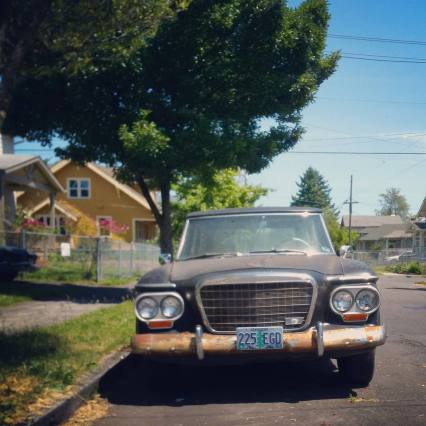 Some of the best ideas come out of the most desperate and dark hours. In the early 60’s with a non-existent budget, Studebaker threw everything they possibly could in every niche direction. Had those innovate ideas on wheels went anywhere there was a host of concepts of where to go if they got enough money in the bank.
Some of the best ideas come out of the most desperate and dark hours. In the early 60’s with a non-existent budget, Studebaker threw everything they possibly could in every niche direction. Had those innovate ideas on wheels went anywhere there was a host of concepts of where to go if they got enough money in the bank.
Alongside the Personal Lux Pioneer Phoenix Grand Turismo Hawk and the Thunderbird/Corvette love child that was the Avanti, Studebaker decided to innovate the way wagons earned their keep on the trusty old Lark platform. All it took was a hole in the roof.

I’m none too sure this particular example still does the the duty it once did. However, there’s some distinct lines to the roof of this station wagon that makes it not only more distinct from your average compact Studebaker Wagon of the 1960’s, but most any station wagon ever made.
Over the cargo/seating area, there’s a sliding panel (not quite a sunroof) that allowed for maximum cargo flexibility. It was perfect for those times you spent too much on a Studebaker Station Wagon and couldn’t afford the delivery fees for your new Fridge, Washer or Dryer! Or, well, the sliding panel offered another way to defy the logic of safety by allowing your children to stand upright cruising down interstate highways at 70 mph through a gaping hole in the roof. In some ways it could be spun as logical, in other ways it might have been the height of needless impracticality unless you really needed to combine the resources of a pick-up truck with a sedan.
 Of course innovation often means a few inherent flaws, and the Wagonaire was no exception. The main culprit was the tendency for the new sliding roof assembly to leak. In traditional American car ownership, most owners don’t seek the advice to keep their more unique products in service. Studebaker’s recommendation to keep the drainage tubes clear was more often not heeded than it was. The result was more than a few unhappy and damp customers.
Of course innovation often means a few inherent flaws, and the Wagonaire was no exception. The main culprit was the tendency for the new sliding roof assembly to leak. In traditional American car ownership, most owners don’t seek the advice to keep their more unique products in service. Studebaker’s recommendation to keep the drainage tubes clear was more often not heeded than it was. The result was more than a few unhappy and damp customers.
Of course there were other niggling issues, such as the actual age of the Studebaker Lark platform (by 1963 the 2nd oldest chassis in production after the soon to be replaced Rambler American), a troublesome new Overhead Valve Inline 6 in base models and some niggling quality control issues that hounded Studebaker for years.
A bigger budget, a newer base, and more diligent quality control (otherwise, maybe if Ford went through with this idea) and we may have had the most revolutionary Station Wagon of all time. As it stands, the Studebaker Wagonaire represents the hope, dreams and possibilities of a babe on a budget. You can’t help but admire their moxie, and wish what was accomplished could have saved the day.
Agreed ~
These were wonderful if flawed Wagons , I remember them when new .
-Nate
LikeLike
GM tried the sliding-roof idea again 40 years later with the mid-size GMC Envoy XUV in 2004-2005. The public still wasn’t buying it, though. A pity. If you had a refrigerator or a water heater that you needed to haul upright, either one was the perfect vehicle for the job.
LikeLike